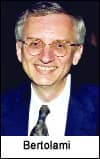 UTHSCA Launches National Practice-Based Research Network
UTHSCA Launches National Practice-Based Research Network
The orthodontic department at the University of Texas Health Science Center at San Antonio (UTHSCSA) is launching a national practice-based research network (PBRN) for orthodontics. A PBRN uses the experience of private-practice clinicians to help design and conduct research studies of direct clinical relevance to their offices. A PBRN has the potential to enroll many patients in a study in a short time period, which permits efficient study of rare events, such as bracket failure. The resulting data will then be compiled and analyzed by the UTHSCSA.
“An important advantage of our research network is the ability to answer questions in a timely manner using large numbers of patients,” says John D. Rugh, DDS, chair of the orthodontic department at UTHSCSA. “For example, in our first study, we were able to examine the bonding of 26,000 teeth in a 2-week period. Completing such a study in a university laboratory would take months, or even years, and even then may not be relevant to a private-practice setting.”
In comparison to traditional university-based research, PBRN results have immediate clinical applicability. Orthodontists in the program have a broader range of skills and experience levels that are more representative of the typical orthodontic practice. In addition, the program enrolls patients who are more representative of private practices.
Faculty and orthodontic residents involved with the national PBRN have developed potential projects on a number of topics, including patient compliance, managing white-spot lesions, the Hawthorne effect on oral hygiene, and the effectiveness of telephone reminders. Study coordinators will also solicit ideas from participating orthodontists.
Porter Research Gives TeleVox High Scores
TeleVox recently commissioned Porter Research, a primary market research firm specializing in health care information technology, to conduct a study of 62 companies that provide Web sites for orthodontic practices. In order to determine which company had the most sites and which sites had the highest search-engine visibility, Porter searched 200 local markets using five different search engines: Google, Yahoo, MSN, AOL, and My Way. In these markets, they located the Web sites of 467 orthodontic practices.
According to T. David Himes, vice president of Porter Research, “Of the 467 orthodontic practice sites in the study, more than 50.1% were TeleVox customers.” TeleVox also had the highest incidence and percentage of first position rankings—a TeleVox site had the first result position in 33.5% of the study’s 200 searches.
Chad Greer, vice president of marketing at TeleVox, says, “TeleVox is known for high-quality Web site design, but this study validates the merits of our hosting services as well. When doctors select TeleVox for Web design and hosting, they benefit from the network of over 3,000 TeleVox Web customers that utilize our services today. This network infrastructure adds a backbone of search engine integrity that no other company can offer.”
Kodak Goes to the Olympics
Kodak’s Health Group provided dental imaging and information systems to assist dental staff at three Olympic polyclinics in Torino, Bardonecchia, and Sestriere, Italy, to treat craniofacial-dental injuries as well as provide standard dental care and treatment for participating athletes in the 2006 Olympics.
“These advanced solutions can streamline processes, improve patient and provider communication, and enhance the level of care provided to Olympic athletes,” says Rich Hirschland, general manager, dental systems, and vice president of Kodak’s Dental Systems Group.
All dental images taken at the Olympics were stored and shared with radiologists and other specialists in case of facial traumas. When the Olympic games concluded, the equipment Kodak provided to the polyclinics remained in Italy and was transferred to local health care organizations.
UCSF and USF Announce DDS/MBA Program

“Student response to this partnership has been overwhelmingly positive,” says Charles N. Bertolami, DDS, DMedSc, dean of the UCSF School of Dentistry.
According to Gary Williams, PhD, dean of the USF School of Business and Management, “We believe that this unique relationship will further engender diversity of interest among USF students, allowing them to interact with men and women of science who will bring a unique perspective to their business coursework.”









